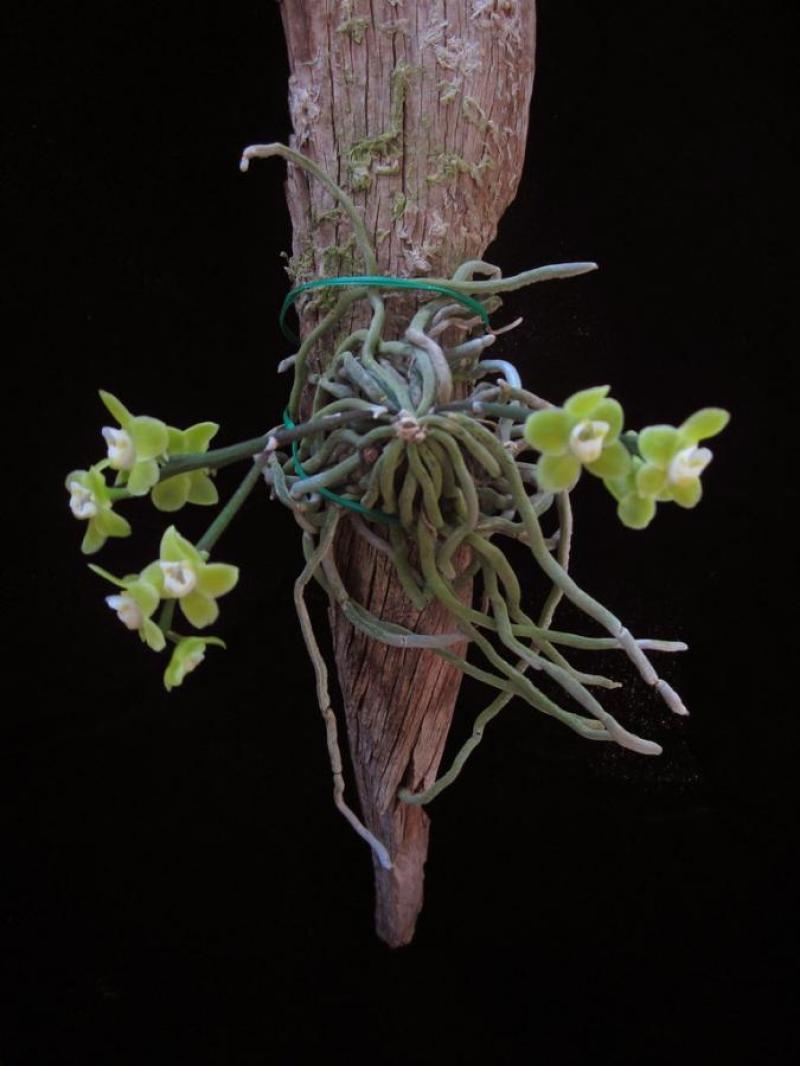Chiloschista viridiflava
Also known as: The Green Yellow Chioschista in the subfamily: Epidendroideae
Native to: Thailand
General Information
The Green Yellow Chioschista is a miniature cool to warm growing epiphytic leafless orchid belonging to the sub family Epidendroideae native to Thailand.
Flowers
Numerous short lasting blossoms appear
Substrate(s)
- Bark
Care Notes
This orchid is leafless so does best mounted, watering daily during warmer months and not so often during the cool months. Keep humidity high at all times to prevent roots from dying back, and provide gentle airflow to ensure that the roots do not gather mould and rot in cool weather. Because of their velamin coating the roots can withstand plenty of light, however it's best to keep them in the shade during hot weather so that the roots do not overheat.
Climate
The orchids are well adapted for hot weather, accompanied by sporadic, unpredictable rainfall and a generally dry climate. They can tolerate a lot of neglect as they are quite used to it, however they can be prone to underwatering and may collapse in cold, wet weather.
For this reason it's best to dedicate a sheltered, protected area for them where the watering can be controlled, such as a corner of a greenhouse or in a sheltered balcony. They can also do well hung near the roof of a shadehouse or sheltered greenhouse where they receive the extra heat but not as much water as other plants.
Grows at low elevations. Rainfall ranges from 8mm to 292mm per day, heaviest in September and lightest in January. Humidity ranges from 58% to 83%, highest in August and lowest in March. Temperature ranges from 12C to 34C, highest in April (23C to 34C) and lowest in January (12C to 28C).Watering
These orchids are sensitive to excessive watering and should only be watered when they look thirsty. Water infrequently and ensure that the roots are dry before watering. Keep an eye on them especially during hot weather as overwatering can lead to rot, whereas underwatering may result in wilting or shriveling, which while unattractive, will not kill the plant.
Fertiliser
Apply liquid based fertiliser per recommended directions. They can benefit from a high phosphate fertiliser leading up to flowering season, followed by a high nitrogen fertiliser when new growth appears, and a balanced fertiliser in other times. These orchids can also tolerate slow release fertiliser applied 1-2 pellets per cup (250ml) of media.
Use balanced fertiliser during Spring and Summer. Apply fertiliser regularly at half strength year round. Use a high Nitrogen fertiliser during Spring and Summer. Use a high Phosphorous fertiliser during Summer.Potting
Due to the growth nature of these plants they are best mounted onto cork, tree fern slabs, or even trees if the climate suits. Water regularly especially in hot weather.
This plant does well mounted to Cork slabs.






